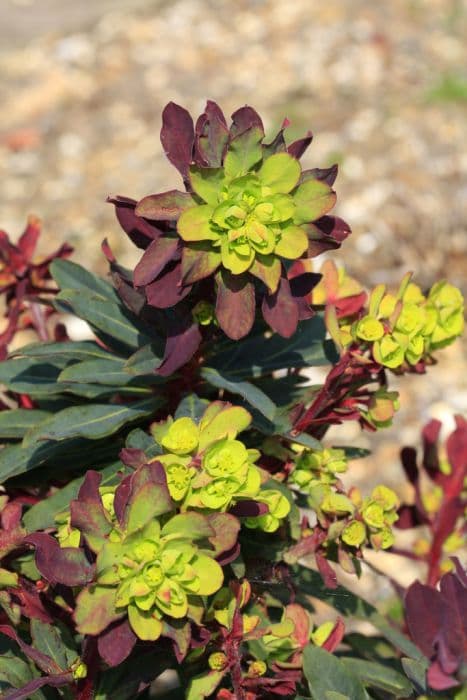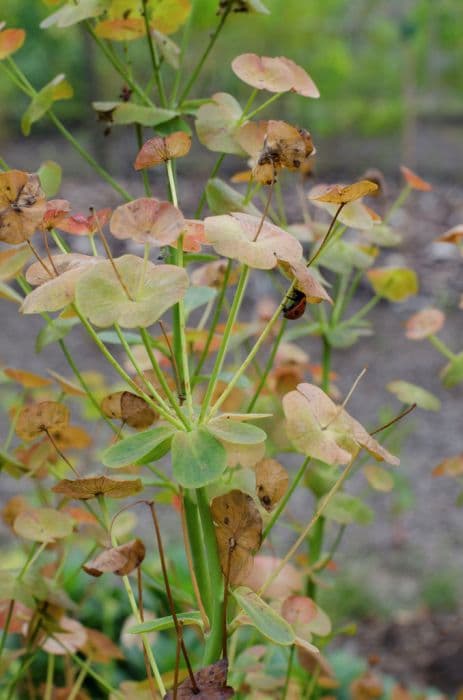Euphorbia 'Whistleberry Garnet'

ABOUT
Euphorbia 'Whistleberry Garnet' is known for its striking foliage and flower combination. The plant showcases a rich tapestry of colorful leaves that often bear a deep green hue, contrasted by reddish or purple margins, giving it a vibrant, ornamental look. The leaves are typically narrow and may have a slightly ruffled or wavy edge, adding to its textured appearance. Throughout the growing season, 'Whistleberry Garnet' produces clusters of small flowers, which are actually bracts, or modified leaves, that surround the true flowers. These bracts are characteristically a bright, eye-catching red or garnet color, providing a dazzling display against the darker foliage. The true flowers, which are much less conspicuous, are small and typically yellow in color. Growing in a compact and bushy form, 'Whistleberry Garnet' presents a mounded shape, with branches that emerge from the base and spread outward. The stems of the plant are sturdy and may display a reddish tinge that complements the overall color scheme of the foliage and bracts. As a member of the Euphorbia family, 'Whistleberry Garnet' shares the characteristic of having a milky, white sap within its stems, which can be an irritant to skin and should be handled with care. The interplay of colors and the structured yet bushy growth habit make this plant an attractive addition to gardens and landscapes, where it can serve as a focal point or a complementary plant among other garden varieties.
About this plant
 Names
NamesSynonyms
Whistleberry Garnet Spurge, Garnet Spurge.
Common names
Euphorbia 'Whistleberry Garnet'
 Toxicity
ToxicityTo humans
The plant in question belongs to the Euphorbia genus, commonly known as spurge. All spurges contain a milky sap known as latex, which can be toxic to humans. If any part of the plant, including the sap, is ingested, it can cause symptoms like nausea, vomiting, and diarhhea. Contact with the skin can lead to irritation, redness, and swelling, while contact with the eyes can cause severe pain and possible vision impairment. If ingested, medical attention should be sought immediately due to the potential severity of the symptoms.
To pets
Spurge is toxic to pets. If animals ingest any part of the plant, they can suffer from symptoms similar to those in humans, such as vomiting, diarrhea, and abdominal pain. The sap can also cause skin and eye irritation. In severe cases, ingestion can lead to more serious symptoms such as weakness, lethargy, and in rare instances, seizures. Owners should prevent pets from having access to these plants, and consult a veterinarian immediately if ingestion or contact is suspected.
 Characteristics
CharacteristicsLife cycle
Perennials
Foliage type
Evergreen
Color of leaves
Green
Flower color
Red
Height
2 feet [61 cm]
Spread
2 feet [61 cm]
Plant type
Shrub
Hardiness zones
Varies
Native area
Mediterranean
Benefits
 General Benefits
General Benefits- Attractive Foliage: The Euphorbia 'Whistleberry Garnet' has vibrant and colorful foliage that provides visual interest to any garden space.
- Drought Tolerance: Once established, it is drought-tolerant, making it a good choice for water-wise gardens and for gardeners looking to conserve water.
- Low Maintenance: This plant requires minimal care, making it ideal for those who want an attractive garden without constant upkeep.
- Pest Resistance: It is known for being resistant to many pests, diminishing the need for chemical pest control.
- Durable: The Euphorbia 'Whistleberry Garnet' is robust and can handle a variety of conditions, which makes it well-suited to many climates.
- Long Blooming: It provides a long season of interest with its blooms, which means more color in the garden for an extended period.
- Attracts Pollinators: The flowers can attract beneficial insects such as bees and butterflies, supporting local ecosystems.
- Adaptable: It can adapt to different soil types, although it prefers well-drained soils, which is useful for less-than-ideal garden beds.
- Seasonal Interest: With flowers and foliage that change color over the seasons, it offers diverse visual interest throughout the year.
- Easy Propagation: The plant can be easily propagated from cuttings, allowing gardeners to expand their collection without additional cost.
 Medical Properties
Medical PropertiesThis plant is not used for medical purposes.
 Air-purifying Qualities
Air-purifying QualitiesThis plant is not specifically known for air purifying qualities.
 Other Uses
Other Uses- Euphorbia 'Whistleberry Garnet', also known as Spurge, can be used in dried flower arrangements, as its unique bracts and foliage provide interesting shapes and textures that last well.
- In landscape design, Spurge serves as an architectural plant, offering a vertical element to garden beds or as a striking solitary specimen.
- Spurge can be utilized as a natural barrier when planted in dense groups due to its irritant sap that deters animals from browsing.
- Photographers and painters often use Spurge as a subject for artistic works due to its vibrant color and distinctive form.
- The sap of Spurge is used in traditional practices to make a fishing tool called ‘birdlime’, which is a sticky substance applied to twigs to catch small birds.
- Spurge can be planted in areas prone to erosion to help stabilize soil with its root systems.
- Enthusiasts of miniature and model landscapes use dried Spurge plants to create realistic trees and shrubs for their setups.
- During festive seasons, Spurge can be incorporated into wreaths and holiday decorations for its punch of color and unique foliage.
- Some cultures use the sharp lines and contrasting colors of Spurge in their floral language, conveying messages through the choice of plants in a bouquet.
- The thick foliage of Spurge provides a microhabitat for beneficial insects, serving as a refuge and hunting ground within a garden ecosystem.
Interesting Facts
 Feng Shui
Feng ShuiThe Spurge is not used in Feng Shui practice.
 Zodiac Sign Compitability
Zodiac Sign CompitabilityThe Spurge is not used in astrology practice.
 Plant Symbolism
Plant Symbolism- Resilience: Euphorbia plants, often known as spurges, are known for their ability to thrive in harsh conditions, symbolizing one's capacity to endure and adapt to difficult situations.
- Protection: Many Euphorbia species have a milky sap that is toxic and can irritate the skin. This characteristic has led to the plant symbolizing protection and the establishment of boundaries.
- Purification: The Euphorbia plant's association with medicinal uses in some cultures has given it the symbolic meaning of purification and the cleansing of negative energy.
- Persistence: The plant's ability to grow in challenging environments symbolizes determination and an unyielding spirit.
- Healing: The medicinal properties attributed to some Euphorbia species highlight the plant's symbolism of healing and recovery.
 Water
WaterSpurge, including the Euphorbia 'Whistleberry Garnet', should be watered once the top inch of soil has dried out, which may vary from once a week to every other week depending on the environment. They prefer to be underwatered rather than overwatered. Use approximately half a gallon of water for a medium-sized plant, ensuring the soil is thoroughly moistened. It's vital not to let the plant sit in water, as this can lead to root rot. During the winter months, reduce watering frequency since the plant goes into dormancy.
 Light
LightThe best lighting condition for Spurge is bright, indirect sunlight. It thrives near a window that provides plenty of light but is shielded from the harsh midday sun. If it is outdoors, partial shade to full sun is ideal, as long as it's not exposed to prolonged intense midday sun which can scorch its leaves.
 Temperature
TemperatureSpurge prefer temperatures between 50 and 85 degrees Fahrenheit. They can survive minimum temperatures as low as 30 degrees Fahrenheit but should not be exposed to freezing conditions for extended periods. The ideal growing temperature range is between 60 and 75 degrees Fahrenheit for optimal growth and health.
 Pruning
PruningSpurge benefits from pruning to remove any diseased or damaged stems and to promote bushier growth. Pruning is best done in late winter or early spring before new growth starts. Typically, it isn't necessary to prune more than once a year unless you're shaping the plant or controlling its size.
 Cleaning
CleaningAs needed
 Soil
SoilThe best soil mix for Euphorbia 'Whistleberry Garnet', commonly known as Spurge, is a well-draining, sandy or gritty substrate with some organic matter. A cactus or succulent potting mix enriched with perlite or pumice works well to ensure proper drainage. The soil pH should be slightly acidic to neutral, ranging from 6.0 to 7.0 for optimal growth.
 Repotting
RepottingSpurge should be repotted every two to three years or when it outgrows its current container. It is best to repot in the spring or early summer, at the beginning of its active growing season. Use a fresh, well-draining soil mix during each repotting to encourage healthy root development.
 Humidity & Misting
Humidity & MistingSpurge thrives in average household humidity levels, preferring a range of 40-60%. It can tolerate some dry air but avoid placing it in overly humid areas, as this can lead to issues with rot or fungal diseases, particularly if the soil stays damp for too long.
 Suitable locations
Suitable locationsIndoor
Place Spurge in bright, indirect light and avoid overwatering.
Outdoor
In partial sun to light shade; protect from intense afternoon sun.
Hardiness zone
6-9 USDA
 Life cycle
Life cycleEuphorbia 'Whistleberry Garnet', commonly known as Spurge, begins its life as a seed, germinating in warm, well-drained soil with sufficient sunlight. Once sprouted, the seedling grows into a juvenile plant, developing its characteristic foliage and branching habit. In its vegetative stage, the Spurge experiences rapid growth and begins to form its unique bracts, which are often mistaken for flowers. Following the vegetative stage, the Spurge enters its reproductive phase, producing clusters of small, actual flowers surrounded by showy bracts which attract pollinators. After pollination, the plant forms fruit capsules that eventually burst open to disperse seeds for the next generation. Finally, as a perennial, the Spurge may enter a period of dormancy during colder months, only to regrow from its root system with the return of favorable conditions.
 Propogation
PropogationPropogation time
Spring-Early Summer
Euphorbia 'Whistleberry Garnet', commonly known as Whistleberry Garnet Spurge, is typically propagated by stem cuttings. This method is popular due to its simplicity and effectiveness. The ideal time to take stem cuttings for propagation is in late spring or early summer when the plant's growth is most vigorous. To propagate by stem cuttings, a gardener would take a healthy cutting of about 4-6 inches (about 10-15 cm) in length, making sure to include a couple of leaf nodes. The cut end of the stem should be allowed to dry and callus over for a few days to prevent rot when planted. Once callused, the cutting can be inserted into a pot with well-draining soil, ensuring at least one node is buried where roots can form. Regular watering and warm temperatures will encourage rooting, and after a few weeks, the cutting should establish itself as a new plant.




![Spurge [Silver Swan]](/_next/image?url=https%3A%2F%2Fplants-admin.emdemapps.com%2Fimages%2Fplants%2F%2Fimages%2F604b573f6c8f6.png&w=640&q=75)




